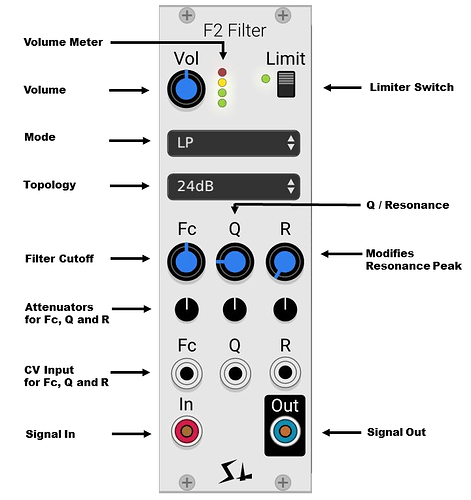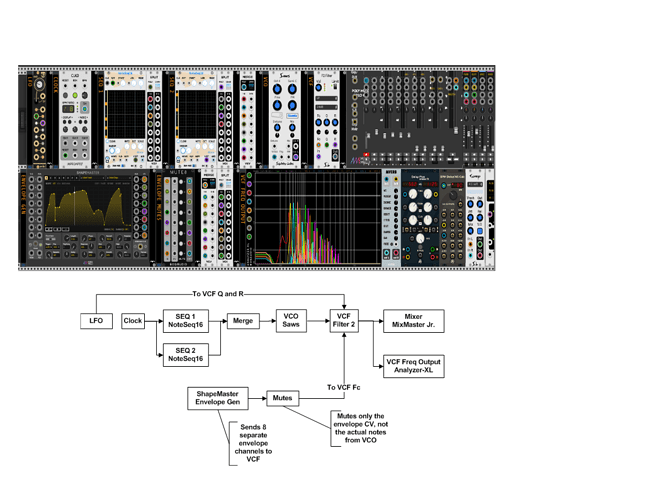It’s another new Squinky Labs module. Well, not that new, but hopefully new to you. It’s a VCF called “F2 Filter”. It has three claims to fame – It sounds pretty nice, it uses an absurdly small amount of CPU, and it doesn’t sound much like other filters. It’s small and easy to use, so if you have a spare moment give it a try!
Just out of curiousity, what did you do to get it so low?
Mostly just my usual tricks, which I wrote down here: https://github.com/squinkylabs/SquinkyVCV/blob/main/docs/efficient-plugins.md
I did a some more finicky optimization for F2 (and for Comp). I’ll describe that here later (right now I’m doing some gardening).
Seems to be my go-to then, thanks Bruce!
Awesome! Can’t wait to give this a spin (and then read the source code  )
)
Is this now on the master branch, or do I still need a special checkout before building?
Ok. Just checked my pull, and it is part of the “real” world.
Yes, merged to master early in the week, now in the library. While it’s possible to submit things to the library that are on a branch, I don’t think people usually do that.
Nothing too special in there (in fact some dumb things), but most of the action is here: https://github.com/squinkylabs/SquinkyVCV/blob/main/composites/F2_Poly.h
(and the things that it uses).
Here’s a video I did when testing the F2 Filter. It sounds great and really does behave differently than other VCFs! I’ll post the Patch for this and others when it hits the library.
Here’s the flowchart for it (it’s not that complicated, but I drew one up anyway).
Thanks! btw, it hit the library earlier today. It just doesn’t show up in the page because the library page knows that I made it before Comp and SFZ Player. But it’s there!
Well, in that case I’ll place more videos and patches today. Thanks!
That “Limit” toggle switch — Is it possible that it’s upside down? Or that it works more like a compressor? When it’s up (LED is lit green) the trace on a spectrum analyzer goes up by about 12 or 16 dB or so. I get similar results with Bogaudio’s VU meter.
All other settings are in the Initialized state, Low Pass and Topology of 12 dB. White noise on the input.
Well, I will have to check. But I believe the story is that there is a preset amount of makeup gain, so when you turn on the “Limiter” it may actually get louder. And, yes, it’s actually a fairly fast compressor with an infinite compression ratio.
There is no control over the limiter, other than the obvious on/off and an “alternate” setting available in the context menu.
So, I think it does what I wanted it to do. But I will need to check.
btw, I just asked the internet “what’s the difference between a limiter and a compressor”. It sent me this from Sound On Sound magazine: “The difference between a compressor and a limiter is only in the compression ratio used.”
My understanding is that when ratio > 10, it’s a limiter
I would’ve said that it’s more about the intended purpose. Limiters stop the top from going higher than some desired level (hence my confusion), to prevent clipping and overmodulation. Compressors push the lower-level signals up so as to give the impression of more perceived loudness and to keep softer passages well above the noise floor. This was my experience, being a retired technician for the Canadian Broadcasting Corporation.
Compression is why CDs got a bad rap. It’s not that vinyl is inherently better, it’s that original tapes (of vinyl classics) “remastered” for CD have way too much compression. This is not to say that compression is bad per se. It has its purposes. [end of rant.]
Oooohhh… let’s not go there ![]() But it’s true, the final sound has an awful lot to do with the quality of the final mastering, and a lot of the “rush to CD” remasterings in the 80’s were awful. But it’s possible to make fantastic sounding CD’s and vinyl both, and to make both sound crappy as well. The biggest factor is the quality of the initial recording though. Most people would be shocked to know that very high quality recordings were made as early as the 1950’s. They had very good microphones and tubeamps back then, but lousy playback equipment, so back then they couldn’t hear how good the recording actually sounded.
But it’s true, the final sound has an awful lot to do with the quality of the final mastering, and a lot of the “rush to CD” remasterings in the 80’s were awful. But it’s possible to make fantastic sounding CD’s and vinyl both, and to make both sound crappy as well. The biggest factor is the quality of the initial recording though. Most people would be shocked to know that very high quality recordings were made as early as the 1950’s. They had very good microphones and tubeamps back then, but lousy playback equipment, so back then they couldn’t hear how good the recording actually sounded.
This is great! I really like the sound of that filter, must play…
Yeah, it’s a really cool VCF. It won’t self-oscillate, so you can do a lot of crazy stuff with it. It loves random voltages!
hey! I think you may be the first person to notice this ![]()
This came up while I was making Stairway. A tester complained that it would burst into oscillation somewhat unpredictably at high frequencies. So I had to make a choice for that I wanted it to do.
The choices seems to me to be: make it self oscillate predictably and in tune, let it be unstable and burst into oscillation, kill the resonance at high frequencies, or tune it to be stable over its entire range while preserving resonance.
Of these, I think the first and the last are both pretty valid, and a matter of taste. I went for the latter, and carefully tuned things to preserve a potentially very high resonance over the frequency range of the filter.
So when I did F2 I kept the same approach. With F2 you can hear it more obviously, because if you leave the limiter on and sweep a high Q setting you can really hear it sweeping around in the high frequencies, even if the input is very low in frequency, as long as there are some harmonics up there.



